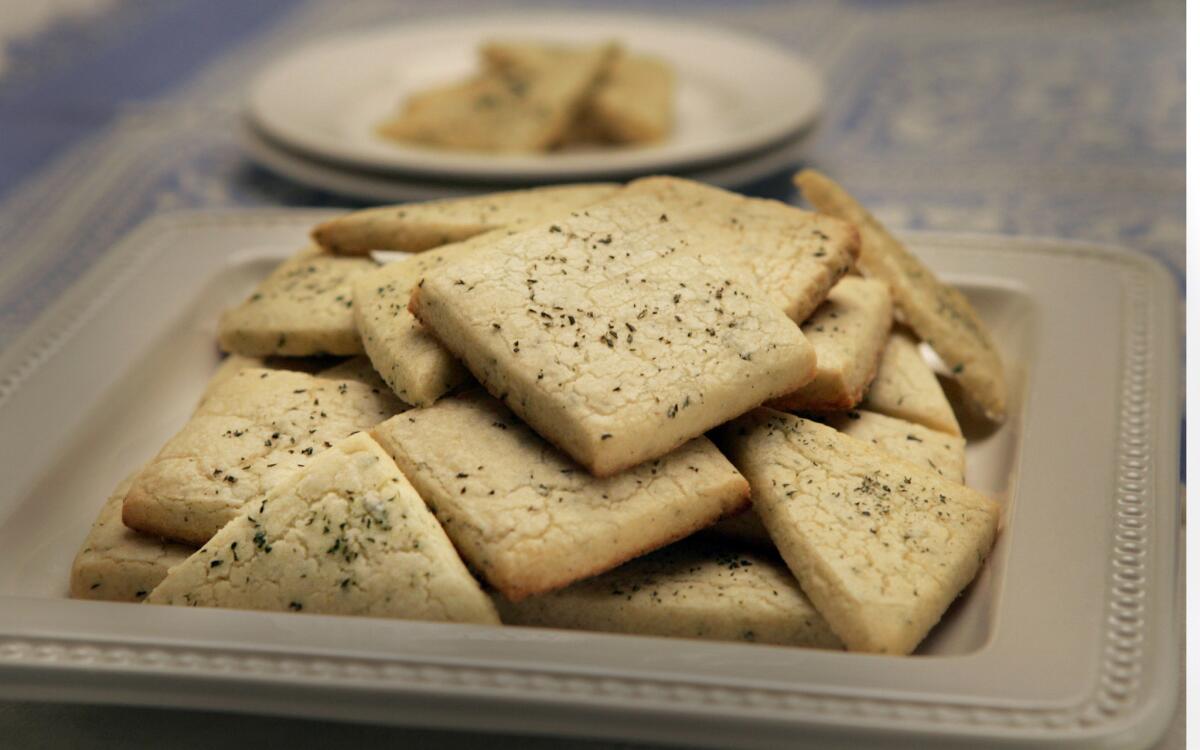Rosemary/thyme cookies

- Share via
One: Who knew both rosemary and thyme were so distinctly fantastic for baking? And two: Who knew rosemary and thyme were so easily interchangeable in all those cookies, crisps, cobblers, even flan?
Put a batch of rosemary or thyme cookies in the oven, and the wintry herbal-floral aromas that fill the kitchen are a crisscross of butter, sugar and a toasty bouquet garni. Rosemary, with hints of pine and lemon, and slightly minty thyme (they’re both members of the mint family) are known for pulling up the flavors of roasted meat or fish; accenting the saltiness in sauces; and defining the vegetable-garden tastes of tomatoes, peppers and onions.
But they work just as fabulously in desserts: creamy custards or panna cotta; buttery cookies; and pies, crisps and cobblers made with fall fruit such as apples and pears.
Like lemon zest or ginger used in baking, rosemary and thyme focus the elements in fruit that aren’t sweet while tempering the sugars. But the two herbs add their own pungent, piney nuances.
Add finely chopped, fresh rosemary or thyme leaves to rolled-out butter cookies, and the fragrant herbs play off vanilla bean seeds and fleur de sel in the batter. The herb-flecked cookies are simultaneously savory and sweet.
Despite the strong essential oils in rosemary leaves, you can use the same amount of either rosemary or thyme in the cookies. Same with cobblers and crisps. A pear crisp gets a butter-flour-brown sugar topping with a tiny bit of ground ginger and a couple of spoonfuls of either fresh chopped rosemary or thyme leaves. The herbs scent the pears in the crisp, mingling with the vanilla and lemon juice that are mixed in with the fruit.
For a creamy, luxurious flan, bruised sprigs of the herbs (with the leaves and stems) are infused in a milk and cream mixture for 1 hour, and the flavor of rosemary becomes much stronger than the flavor of thyme. So, in this case, you would use more thyme than rosemary in the recipe. Once the flan is baked, it’s allowed to cool, then refrigerated overnight, and the flavor of the herb becomes a little stronger.
The flan’s layer of unctuous, sweet caramel is especially delicious with the creamy, herbal custard. Now you know.
Heat the oven to 375 degrees. Sift together the flour and baking powder in a medium bowl. Stir in the fleur de sel.
Cream the butter in the bowl of a stand mixer fitted with the paddle attachment (or in a medium bowl using a hand mixer). With the tip of a knife, scrape the vanilla bean seeds into the butter. Continue to beat until blended. Add the sugar and mix until light and fluffy, making sure to scrape down the sides of the bowl. Beat in the rosemary or thyme, then beat in the egg just until blended.
Beat in the flour mixture just until the dough is well-mixed. Remove the dough from the bowl and flatten into a disk. Wrap the dough in plastic wrap, and chill it for 15 minutes.
Remove the plastic wrap and roll the dough out on a lightly floured surface to one-fourth-inch thick. Cut out cookies into 2-inch squares, rounds or triangles. Place them on a buttered cookie sheet. Lightly brush the tops of each cookie with milk, then sprinkle with a little rosemary or thyme. Place the cookie sheet in the refrigerator to allow the cookies to chill an additional 15 minutes.
Bake the cookies for 9 to 12 minutes, until the cookies have faint coloring around the edges. Remove the tray from the oven, and transfer the cookies to a wire rack to cool.
Get our Cooking newsletter.
Your roundup of inspiring recipes and kitchen tricks.
You may occasionally receive promotional content from the Los Angeles Times.
















